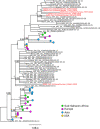Transmission of SARS-CoV-2 in northern Ghana: insights from whole-genome sequencing
- PMID: 33723631
- PMCID: PMC7959303
- DOI: 10.1007/s00705-021-04986-3
Transmission of SARS-CoV-2 in northern Ghana: insights from whole-genome sequencing
Abstract
Following the detection of the first imported case of COVID-19 in the northern sector of Ghana, we molecularly characterized and phylogenetically analysed sequences, including three complete genome sequences, of severe acute respiratory syndrome coronavirus 2 obtained from nine patients in Ghana. We performed high-throughput sequencing on nine samples that were found to have a high concentration of viral RNA. We also assessed the potential impact that long-distance transport of samples to testing centres may have on sequencing results. Here, two samples that were similar in terms of viral RNA concentration but were transported from sites that are over 400 km apart were analyzed. All sequences were compared to previous sequences from Ghana and representative sequences from regions where our patients had previously travelled. Three complete genome sequences and another nearly complete genome sequence with 95.6% coverage were obtained. Sequences with coverage in excess of 80% were found to belong to three lineages, namely A, B.1 and B.2. Our sequences clustered in two different clades, with the majority falling within a clade composed of sequences from sub-Saharan Africa. Less RNA fragmentation was seen in sample KATH23, which was collected 9 km from the testing site, than in sample TTH6, which was collected and transported over a distance of 400 km to the testing site. The clustering of several sequences from sub-Saharan Africa suggests regional circulation of the viruses in the subregion. Importantly, there may be a need to decentralize testing sites and build more capacity across Africa to boost the sequencing output of the subregion.
Conflict of interest statement
The authors declare that they have no competing interests.
Figures


References
-
- Paraskevis D, Kostaki EG, Magiorkinis G, Panayiotakopoulos G, Sourvinos G, et al. Full-genome evolutionary analysis of the novel corona virus (2019-nCoV) rejects the hypothesis of emergence as a result of a recent recombination event. Infect Genet Evol. 2020;79:104212. doi: 10.1016/j.meegid.2020.104212. - DOI - PMC - PubMed
Publication types
MeSH terms
Grants and funding
LinkOut - more resources
Full Text Sources
Other Literature Sources
Medical
Miscellaneous

